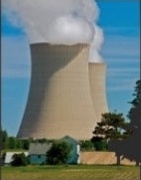Last February’s explosion at the WIPP dump for long-lived intermediate-level nuclear waste from the US’s nuclear weapons program remains unexplained, writes Jim Green. But with the site’s history of ignored warnings, ‘missing’ safety culture, lack of supervision and dubious contractor appointments, it surely came as no surprise – and further accidents appear inevitable.
The precise cause of the February 14 accident involving a radioactive waste barrel at the world’s only deep geological radioactive waste repository has yet to be determined, but information about the accident continues to come to light.
The Waste Isolation Pilot Plant (WIPP) in New Mexico, USA, is a dump site for long-lived intermediate-level waste from the US nuclear weapons program. More than 171,000 waste containers are stored in salt caverns 2,100 feet (640 meters) underground.
On February 14, a heat-generating chemical reaction – the Department of Energy (DOE) calls it a ‘deflagration’ rather than an explosion – compromised the integrity of a barrel and spread contaminants through more than 3,000 feet of tunnels, up the exhaust shaft, into the environment, and to an air monitoring approximately 3,000 feet north-west of the exhaust shaft. [1]
The accident resulted in 22 workers receiving low-level internal radiation exposure.
‘The contractors were not exactly meticulous’
Investigators believe a chemical reaction between nitrate salts and organic ‘kitty litter’ used as an absorbent generated sufficient heat to melt seals on at least one barrel.
But experiments have failed to reproduce the chemical reaction, and hundreds of drums of similarly packaged nuclear waste are still intact, said DOE spokesperson Lindsey Geisler. “There’s still a lot we don’t know”, she said. [2]
Terry Wallace from Los Alamos National Laboratory (LANL) said: “LANL did not consider the chemical reactions that unique combinations of radionuclides, acids, salts, liquids and organics might create.” [3]
[…]
Major deficiencies at Los Alamos National Laboratory
Of immediate relevance to the February 14 WIPP accident are problems at Los Alamos National Laboratory (LANL). The waste barrel involved in the accident was sent from LANL to WIPP. LANL staff approved the switch from an inorganic clay absorbent to an organic material in September 2013.
That switch is believed to be one of the causes of the February 14 accident. LANL also approved the use of a neutraliser that manufacturers warned shouldn’t be mixed with certain chemicals. [10]
[…]
“In particular, we noted that:
- Despite specific direction to the contrary, LANL made a procedural change to its existing waste procedures that did not conform to technical guidance provided by the Department for the processing of nitrate salt waste; and
- Contractor officials failed to ensure that changes to waste treatment procedures were properly documented, reviewed and approved, and that they incorporated all environmental requirements for TRU waste processing. These weaknesses led to an environment that permitted the introduction of potentially incompatible materials to TRU storage drums. Although yet to be finally confirmed, this action may have led to an adverse chemical reaction within the drums resulting in serious safety implications.”
Compromised response to the accident
A degraded safety culture was responsible for the accident, and the same failings inevitably compromised the response to the accident. Among other problems: [4,6]
- The DOE contractor could not easily locate plutonium waste canisters because the DOE did not install an upgraded computer system to track the waste inside WIPP.
- The lack of an underground video surveillance system made it impossible to determine if a waste container had been breached until long after the accident. A worker inspection team did not enter the underground caverns until April 4 – seven weeks after the accident.
- The WIPP computerized Central Monitoring System has not been updated to reflect the current underground configuration of underground vaults with waste containers.
- 12 out of 40 phones did not work so emergency communications could not reach all parts of WIPP in the immediate aftermath of the accident.
- WIPP’s ventilation and filtration system did not prevent radiation reaching the surface, due to neglect.
- The emergency response moved in slow motion. The first radiation alarm sounded at 11.14pm. Not until 9.34am did managers order workers on the surface of the site to move to a safe location.
Everything that was supposed to happen, didn’t. Everything that wasn’t supposed to happen, did.
Featured Topics / 特集
-

A nuclear power plant in Byron, Illinois. Taken by photographer Joseph Pobereskin (http://pobereskin.com). カレンダー
-
Latest Posts / 最新記事
- 被爆者らのゲノム解析 放影研方針、次世代への影響調査 via 日本経済新聞 2024/03/04
- 「おなか張る」から、亡くなるまで4カ月…生身の人間を苦しめたトロトラスト 知識ゼロから始まった「日本初の薬害」の取材 via 信濃毎日新聞 2024/02/29
- 福島第1原発で汚染水トラブル連発、経済産業相が東京電力を指導 「覚悟が見えない」地元もバッサリvia東京新聞 2024/02/23
- It’s not just toxic chemicals. Radioactive waste was also dumped off Los Angeles coast via LA Times 2024/02/21
- 仏で保管のプルトニウム 九州電力と四国電力の原発で利用へ via NHK News Web 2024/02/17
Discussion / 最新の議論
- Leonsz on Combating corrosion in the world’s aging nuclear reactors via c&en
- Mark Ultra on Special Report: Help wanted in Fukushima: Low pay, high risks and gangsters via Reuters
- Grom Montenegro on Duke Energy’s shell game via Beyond Nuclear International
- Jim Rice on Trinity: “The most significant hazard of the entire Manhattan Project” via Bulletin of Atomic Scientists
- Barbarra BBonney on COVID-19 spreading among workers on Fukushima plant, related projects via The Mainichi
Archives / 月別アーカイブ
- March 2024 (1)
- February 2024 (6)
- January 2024 (4)
- November 2023 (8)
- October 2023 (1)
- September 2023 (7)
- August 2023 (5)
- July 2023 (10)
- June 2023 (12)
- May 2023 (15)
- April 2023 (17)
- March 2023 (20)
- February 2023 (19)
- January 2023 (31)
- December 2022 (11)
- November 2022 (12)
- October 2022 (7)
- September 2022 (6)
- August 2022 (22)
- July 2022 (29)
- June 2022 (15)
- May 2022 (46)
- April 2022 (36)
- March 2022 (47)
- February 2022 (24)
- January 2022 (57)
- December 2021 (27)
- November 2021 (32)
- October 2021 (48)
- September 2021 (56)
- August 2021 (53)
- July 2021 (60)
- June 2021 (55)
- May 2021 (48)
- April 2021 (64)
- March 2021 (93)
- February 2021 (69)
- January 2021 (91)
- December 2020 (104)
- November 2020 (126)
- October 2020 (122)
- September 2020 (66)
- August 2020 (63)
- July 2020 (56)
- June 2020 (70)
- May 2020 (54)
- April 2020 (85)
- March 2020 (88)
- February 2020 (97)
- January 2020 (130)
- December 2019 (75)
- November 2019 (106)
- October 2019 (138)
- September 2019 (102)
- August 2019 (99)
- July 2019 (76)
- June 2019 (52)
- May 2019 (92)
- April 2019 (121)
- March 2019 (174)
- February 2019 (146)
- January 2019 (149)
- December 2018 (38)
- November 2018 (51)
- October 2018 (89)
- September 2018 (118)
- August 2018 (194)
- July 2018 (22)
- June 2018 (96)
- May 2018 (240)
- April 2018 (185)
- March 2018 (106)
- February 2018 (165)
- January 2018 (241)
- December 2017 (113)
- November 2017 (198)
- October 2017 (198)
- September 2017 (226)
- August 2017 (219)
- July 2017 (258)
- June 2017 (240)
- May 2017 (195)
- April 2017 (176)
- March 2017 (115)
- February 2017 (195)
- January 2017 (180)
- December 2016 (116)
- November 2016 (115)
- October 2016 (177)
- September 2016 (178)
- August 2016 (158)
- July 2016 (201)
- June 2016 (73)
- May 2016 (195)
- April 2016 (183)
- March 2016 (201)
- February 2016 (154)
- January 2016 (161)
- December 2015 (141)
- November 2015 (153)
- October 2015 (212)
- September 2015 (163)
- August 2015 (189)
- July 2015 (178)
- June 2015 (150)
- May 2015 (175)
- April 2015 (155)
- March 2015 (153)
- February 2015 (132)
- January 2015 (158)
- December 2014 (109)
- November 2014 (192)
- October 2014 (206)
- September 2014 (206)
- August 2014 (208)
- July 2014 (178)
- June 2014 (155)
- May 2014 (209)
- April 2014 (242)
- March 2014 (190)
- February 2014 (170)
- January 2014 (227)
- December 2013 (137)
- November 2013 (164)
- October 2013 (200)
- September 2013 (255)
- August 2013 (198)
- July 2013 (208)
- June 2013 (231)
- May 2013 (174)
- April 2013 (156)
- March 2013 (199)
- February 2013 (191)
- January 2013 (173)
- December 2012 (92)
- November 2012 (198)
- October 2012 (229)
- September 2012 (207)
- August 2012 (255)
- July 2012 (347)
- June 2012 (230)
- May 2012 (168)
- April 2012 (116)
- March 2012 (150)
- February 2012 (198)
- January 2012 (292)
- December 2011 (251)
- November 2011 (252)
- October 2011 (364)
- September 2011 (288)
- August 2011 (513)
- July 2011 (592)
- June 2011 (253)
- May 2011 (251)
- April 2011 (571)
- March 2011 (494)
- February 2011 (1)
- December 2010 (1)
Top Topics / TOPトピック
- anti-nuclear
- Atomic Age
- Capitalism
- East Japan Earthquake + Fukushima
- energy policy
- EU
- France
- Hanford
- health
- Hiroshima/Nagasaki
- Inequality
- labor
- Nuclear power
- nuclear waste
- Nuclear Weapons
- Radiation exposure
- Russia/Ukraine/Chernobyl
- Safety
- TEPCO
- U.S.
- UK
- エネルギー政策
- メディア
- ロシア/ウクライナ/チェルノブイリ
- 健康
- 公正・共生
- 兵器
- 再稼働
- 労働における公正・平等
- 原子力規制委員会
- 原発推進
- 反原発運動
- 大飯原発
- 安全
- 広島・長崎
- 廃炉
- 東京電力
- 東日本大震災・福島原発
- 汚染水
- 米国
- 脱原発
- 被ばく
- 資本主義
- 除染
- 食の安全
Choose Language / 言語



